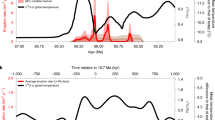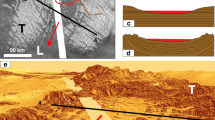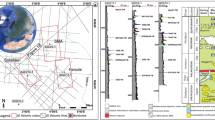Abstract
NETWORKS of small fluvial valleys are extensively developed throughout the ancient heavily cratered terrains of Mars1–3. The existence of the valleys has been cited as compelling evidence for a relatively dense primordial atmosphere capable of maintaining an Earth-like hydrological cycle. Theoretical models of early atmospheric evolution4,5 describe the maintenance of a dense CO2 atmosphere and a warm, wet climate until the end of the heavy-bombardment phase of impacting. However, the presence of very young, Earth-like fluvial valleys on the northern flank of Alba Patera6–8 conflicts with this scenario. Whereas the widespread ancient martian valleys generally have morphologies indicative of sapping erosion by the slow outflow of subsurface water9,3, the local Alba valleys were probably formed by surface-runoff processes. Because subsurface water flow might be maintained by hydro-thermal energy inputs10,11 and because surface-runoff valleys developed late in martian history, when planet-wide climatic conditions were presumably similar to the present, it is not necessary to invoke drastically different planet-wide climatic conditions to explain valley development on Mars. The Alba fluvial valleys can be explained by hydrothermal activity or outflow-channel discharges that locally modified the atmosphere inducing precipitation and local overland flow on low-permeability volcanic ash.
This is a preview of subscription content, access via your institution
Access options
Subscribe to this journal
Receive 51 print issues and online access
$199.00 per year
only $3.90 per issue
Buy this article
- Purchase on Springer Link
- Instant access to full article PDF
Prices may be subject to local taxes which are calculated during checkout
Similar content being viewed by others
References
Pieri, D. Icarus 27, 941–952 (1976).
Carr, M. & Clow, G. Icarus 48, 91–117 (1981).
Baker, V. R. The Channels of Mars (University of Texas Press, Austin, 1982).
Pollack, J. B. & Toon, O. B. Icarus 50, 259–287 (1982).
Pollack, J. B., Kasting, J. F., Richardson, S. M. & Poliakoff, K. Icarus 71, 203–224 (1987).
Gulick, V. C. & Baker, V. R. 18th Lunar Planet. Sci Conf. 639–640 (Lunar and Planetary Institute, Houston, 1987).
Gulick, V. C. & Baker, V. R. Proc. 4th Int. Conf. Mars 121–122 (1989).
Gulick, V. C. & Baker, V. R. J. geophys. Res. (submitted).
Pieri, D. Science 210, 895–897 (1980).
Brakenridge, G. R., Newsom, H. E. & Baker, V. R. Geology 13, 859–862 (1985).
Gulick, V. C., Marley, M. S. & Baker, V. R. 19th Lunar Planet. Sci. Conf. 441–442 (Lunar and Planetary Institute, Houston, 1988).
Barlow, N. G. Icarus 75, 285–305 (1988).
Scott, D. H. & Tanaka, K. L. U.S. Geol. Surv. Geologic Series Map I-1802-A, scale 1:15,000,000 (U.S. Geological Survey, Denver, 1986).
Grant, J. A. NASA Tech. Memo. 89871, 1–286 (National Aeronautics and Space Administration, Washington, DC, 1987).
Baker, V. R. & Partridge, J. B. J. geophys. Res. 91, 3561–3572 (1986).
Gregory, K. J. in Geomorphology and Climate (ed. Derbyshire, E.) 289–315 (Wiley, New York, 1976).
Laity, J. & Malin, M. Geol. Surv. Am. Bull. 96, 203–217 (1985).
Neukum, G. & Hiller, K. J. geophys. Res. 86, 3097–3121 (1981).
Hartmann, W. K. et al. in Basaltic Volcanism on the Terrestrial Planets (eds Basaltic Volcanism Study Project) 1049–1127 (Pergamon, New York, 1982).
Wetherill, G. W. Proc. 8th Lunar Planet. Sci. Conf. (ed. Merrill, R.) 1–16 (Pergamon, New York, 1977).
Mouginis-Mark, P. J., Wilson, L. & Zimbleman, J. R. Bull. Volcanology 50, 361–379 (1988).
Gulick, V. C. thesis, Univ. of Arizona, 1987.
Baker, V. R. NASA Tech. Memo. 88383, 414–416 (National Aeronautics and Space Administration, Washington, DC, 1986).
Kochel, R. C. & Piper, J. F. J. geophys. Res. 91, E175–E192 (1986).
Carr, M. J. Icarus 56, 476–495 (1983).
Carr, M. J. Nature 326, 30–34 (1987).
Clow, G. D. Icarus 72, 95–127 (1987).
Lucchitta, B., Ferguson, H. & Summers, C. J. geophys. Res. 91, E166–E174 (1986).
Wu, C. S. NASA Tech. Memo. 88383, 614–617 (National Aeronautics and Space Administration, Washington, DC, 1986).
Thomas, P. & Ververka, J. J. geophys. Res. 84, 8131–8146 (1979).
Author information
Authors and Affiliations
Rights and permissions
About this article
Cite this article
Gulick, V., Baker, V. Fluvial valleys and martian palaeoclimates. Nature 341, 514–516 (1989). https://doi.org/10.1038/341514a0
Received:
Accepted:
Issue Date:
DOI: https://doi.org/10.1038/341514a0
This article is cited by
-
Volcanic craters and cones in central Kachchh mainland, western India: Potential analogue for the Martian studies?
Journal of Earth System Science (2022)
-
Geologic Constraints on Early Mars Climate
Space Science Reviews (2019)
-
New Martian valley network volume estimate consistent with ancient ocean and warm and wet climate
Nature Communications (2017)
-
Exceptional river gorge formation from unexceptional floods
Nature Communications (2015)
Comments
By submitting a comment you agree to abide by our Terms and Community Guidelines. If you find something abusive or that does not comply with our terms or guidelines please flag it as inappropriate.



